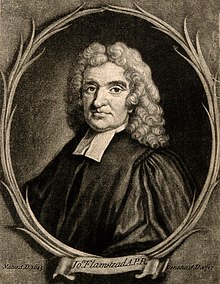John Flamsteed

John Flamsteed (born August 19, 1646 in Denby , † December 31, 1719 in Greenwich ) was an English astronomer and since 1675 the first court astronomer ( Astronomer Royal ) of the English royal family.
Life
John Flamsteed was the only son of Stephen Flamsteed, a businessman, and his first wife, Mary Spadman, from Denby, Derbyshire. Although he became a theologian, his real interest was in astronomy. In self-study he taught himself to calculate eclipses and planetary positions. Somehow some of these calculations ended up in the hands of the astronomer and mathematician Immanuel Halton (1628–1699), who was enthusiastic about the talent of the young talent. Even Lord Brouncker , the then President of the Royal Society , found out about it, and there was an exchange of correspondence with various scholars in London, including Henry Oldenburg , John Collins and William Molyneux belonged.
At the age of less than 23, Flamsteed set out to meet the men of the Royal Society personally. And when Charles II was looking for a royal astronomer, Flamsteed was suggested to him. On March 4, 1675 he was appointed by royal decree to The King's Astronomical Observator , the "Astronomical Observer of the King" and was thus the first Astronomer Royal ("Royal Astronomer"). Astronomer Flamsteed received a pension of £ 100 a year.
At Flamsteed's suggestion, another royal decree established the Royal Greenwich Observatory in 1675 , and Flamsteed laid the foundation stone in August. In February 1676 he became a member of the Royal Society and in July he moved to the observatory where he lived until he was called to pastor of the Burstow Ward , Surrey , in 1684 . He practiced this profession and that of the Astronomer Royal until his death in 1719. In 1720 he was buried in Burstow. From 1699 he was a corresponding member of the Académie des Sciences in Paris.
Flamsteed is also known for his argument with Isaac Newton , who was then President of the Royal Society. Newton tried to steal some of Flamsteed's observations and pass them off as his own, which he succeeded in doing with the help of a royal edict; Newton arranged for Flamsteed's observations to be published. He then published it without naming Flamsteed as the discoverer. Years later, Flamsteed managed to buy back most of the copies of the published books, and he eventually burned them publicly in front of the Royal Observatory .
In honor of Flamsteed, the lunar crater Flamsteed and the asteroid (4987) Flamsteed were named after him.
Scientific work
Flamsteed began his career with an important treatise on the determination of the equation of time .
He collected the data of around 2,800 stars visible over England , which he observed with mostly self-made instruments, and devised a system for their systematic naming with the so-called Flamsteed numbers , which is still used today. This system first appeared in his Historia coelestis Britannica , published by Newton in 1712, but without authorization from Flamsteed. After Flamsteed's death, another edition of the Historia was published in 1725, supplemented by Edmond Halley, and in 1729 the Atlas coelestis .
In the years 1666 and 1668 Flamsteed precisely calculated the solar eclipses . He made the first recorded observation of the planet Uranus , which he believed to be a star and included it in his catalog of stars as 34 Tauri .
Legend
According to legend, King Charles II ordered the killing of the Tower Ravens when John Flamsteed discovered their droppings on his telescope. However, when he was told a legend that the White Tower, the monarchy and the entire kingdom would perish if the ravens ever left the Tower, he let himself be dissuaded.
See also
Web links
- Entry to Flamsteed; John (1646-1719); Astronomer in the Archives of the Royal Society , London
- Electronic facsimile editions of the book collection of the Vienna University Observatory
Individual evidence
- ^ List of members since 1666: Letter F. Académie des sciences, accessed on November 13, 2019 (French).
- ↑ J. Flamsteed: De inaequilitate dierum solarium dissertatio astronomica. London 1672. (online)
- ↑ M. Flamsteed, J. Hodgson (Ed.): Historia Coelestis Britannica. London 1725. Part 1: digitized , part 2: digitized , part 3: digitized .
- ↑ M. Flamsteed, J. Hodgson (Ed.): Atlas Coelestis. London 1753. ( Digitized in the Internet Archive )
- ↑ hrp.org.uk: The ravens , accessed October 28, 2008
| personal data | |
|---|---|
| SURNAME | Flamsteed, John |
| BRIEF DESCRIPTION | English astronomer |
| DATE OF BIRTH | August 19, 1646 |
| PLACE OF BIRTH | Denby , Derbyshire |
| DATE OF DEATH | December 31, 1719 |
| Place of death | Greenwich , England |